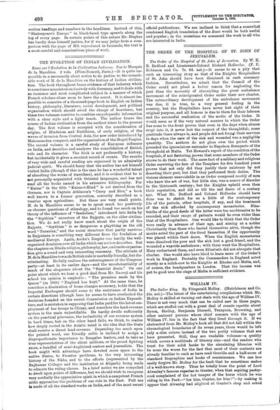TB ORDER OF TILE HOSPITAL OF ST. JOHN OF JERUSALEM.
The Order of the Hospital of St. John of Jerusalem. By W. K.
R. Bedford and Lieutenant-Colonel Richard Holbeche. (F. E. Robinson and Co. 7s. 6d. net.)—It seems to us a pity that such an interesting story as that of the Knights Hospitallers of St. John should have been dismissed in such summary fashion. Nevertheless, we admit that the Council of the Order could not plead a better reason for neglecting the past than the necessity of chronicling the great ambulance movement of the reinvigorated Order under their new charter. The extraordinary development of the ambulance movement was due, it is true, to a very general feeling in the country, but the Hospitallers have never lost sight of their original purpose, and all honour is due to them for their labours and the successful realisation of the motto of the Order. It would seem as if the very natural manner in which the Order has come to the front proves that even in the days when abuses crept into it, it never lost the respect of the thoughtful ; some gratitude there always is, and people did not forg4t their services in days when the care of the sick and wounded was a negligible quantity. The authors do not gloss over the period which preceded the ignominious surrender to Napoleon Bonaparte of the stronghold at Malta. Yet Howard's report of the condition of the hospitals, if not flattering, proves that some members of the Order strove to do their work. The mere fact of a military and religious Order surviving the fate of the Templars for five hundred years proves that not only did • they justify their existence by not deserting their post, but that they performed their duties. The vicious element unavoidable in an Order composed mostly of men who knew the art of war, but little else, was a source of disorder in the thirteenth century; but the Knights upheld even then their reputation, and did so till the sad fiasco of a century ago. What Mr. Bedford and Colonel Holbeche should have done was to sketch for us a little of the contemporary life of the periods, other hospitals, if any, and the treatment of the sick afforded by contemporary monasteries. Nine- tenths of the good deeds of the latter were too unobtrusive to be recorded, and their range of patients would be even wider than that of the Hospitallers. One would like to think that the Order were really in advance of their age, and aiming at a nobler Christianity than those who buried themselves alive, though the monks acted the part of the Good Samaritan if the opportunity was placed within their doors. When the English monasteries were dissolved the poor and the sick lost a good friend, and the wounded a wayside ambulance; with them went the Hospitallers. Mary rechartered them, and even Elizabeth did not abrogate that charter. One would also have liked to learn more of the Order's work in England. Probably the Commanders in England acted merely as a much-cow to the Knights at Rhodes and Malta, and, of course, the headquarters in London. That the income was put to good uses the siege of Malta is sufficient evidence.


























































 Previous page
Previous page